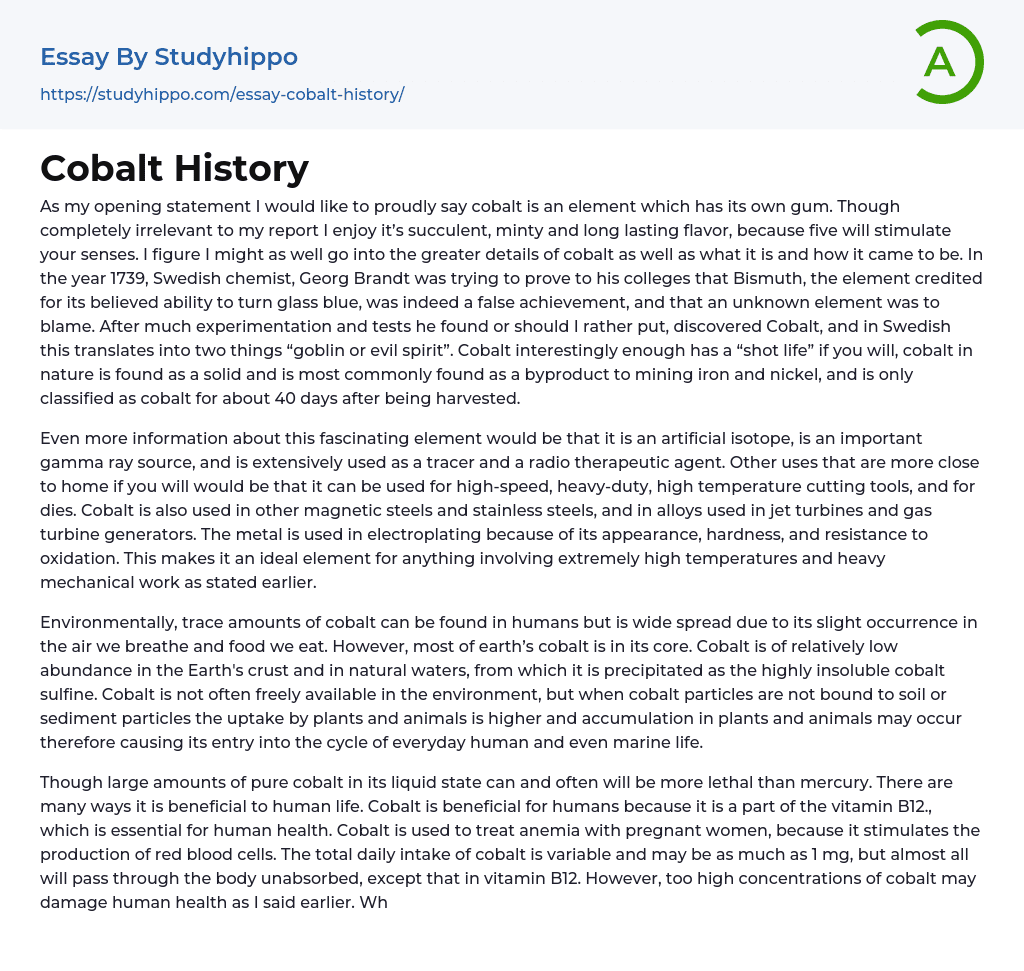I am pleased to announce that cobalt is a unique element with its own gum. While not relevant to my report, I enjoy its juicy, minty, and long-lasting flavor because it stimulates the senses. Moving forward, I will provide more information about cobalt, including its definition and origins. In 1739, Swedish chemist Georg Brandt aimed to prove that Bismuth's alleged ability to turn glass blue was actually an incorrect claim and that an unknown element was responsible instead. After extensive experimentation and testing, Brandt discovered Cobalt, which means "goblin or evil spirit" in Swedish. Interestingly enough, cobalt has a short lifespan. It occurs naturally as a solid and is commonly produced as a byproduct of iron and nickel mining. Its classification as cobalt lasts for only approximately 40 days after extraction.
This text discu
...sses an artificial isotope known as cobalt. Cobalt serves as a crucial gamma ray source and is extensively used as both a tracer and a radio therapeutic agent. Moreover, cobalt can also be utilized for high-speed, heavy-duty, high-temperature cutting tools and dies. It plays a significant role in manufacturing magnetic steels, stainless steels, alloys for jet turbines, and gas turbine generators. The metal's appearance, hardness, and resistance to oxidation make it suitable for tasks like electroplating. Overall, cobalt is an ideal choice for tasks involving extremely high temperatures and heavy mechanical work due to its properties.
Cobalt can be found in small quantities in humans, making it widely distributed due to its presence in the air and food. However, most cobalt is located in Earth's core, with limited abundance in the crust and natural bodies of water where
it forms insoluble precipitates known as cobalt sulfine. Generally, cobalt is not readily available in the environment. Nevertheless, plants and animals can absorb unbound cobalt particles if they are not bound to soil or sediment particles, leading to accumulation. As a result, cobalt becomes part of both human and marine life cycles.
While liquid cobalt can be more dangerous than mercury in large amounts, it has several benefits for humans. It is a vital part of vitamin B12, which is essential for human health and plays a crucial role. Liquid cobalt is also used to treat anemia in pregnant women by stimulating the production of red blood cells. The daily intake of cobalt can vary and reach up to 1 mg, but most of it passes through the body without being absorbed except for the cobalt found in vitamin B12. However, excessive levels of cobalt can be harmful when inhaled, leading to lung-related issues like asthma and pneumonia, especially among those who work with cobalt.
Cobalt's periodic information can be identified through the abbreviation or symbol Co, its atomic number is 27, and it belongs to period 4 group 9. The precise atomic weight of cobalt is 58.933195 micrograms. In further detail, cobalt has a total of 40 isotopes, of which 1 is stable, 11 are radioactive, and 11 are isomers, resulting in a grand total of 40. Cobalt's electron configuration is [Ar]4s23d7, although its exact meaning is not clear. Nonetheless, it holds significance.
Now, part of this report involves understanding and listing the physical and chemical properties of Cobalt. A few years ago, I conducted a similar project but cannot remember
all the properties currently. Cobalt has the appearance of a hard, brittle metal similar to iron and nickel. Its metallic permeability is around two-thirds that of iron. Over a wide temperature range, cobalt tends to exist as a mixture of two allotropes, although I am unsure about the exact calculations. This transformation happens slowly, leading to significant variation in reported data on cobalt's physical properties. Personally, I believe that cobalt surpasses iron, but that is only my opinion.
I have enjoyed sharing information about cobalt with you, but I have reached the end of my report and have no more information to provide. In conclusion, remember that if you believe cobalt is merely a gum flavor sold at Wal-Mart, reconsider your understanding.
- Organic Chemistry essays
- Acid essays
- Calcium essays
- Chemical Bond essays
- Chemical Reaction essays
- Chromatography essays
- Ethanol essays
- Hydrogen essays
- Periodic Table essays
- Titration essays
- Chemical reactions essays
- Osmosis essays
- Carbohydrate essays
- Carbon essays
- Ph essays
- Diffusion essays
- Copper essays
- Salt essays
- Concentration essays
- Sodium essays
- Distillation essays
- Amylase essays
- Magnesium essays
- Acid Rain essays
- Russian Empire essays
- Ancient Greece essays
- British Empire essays
- Historical Figures essays
- Nazi Germany essays
- Roman Empire essays
- War essays
- Revolution essays
- 19Th Century essays
- Historiography essays
- History of the United States essays
- 20Th Century essays
- World History essays
- Vikings essays
- Declaration of Independence essays
- Civilization essays
- Evidence essays
- Genocide essays
- Colonialism essays
- Rebellion essays
- 1960S essays
- 1920S essays
- 1950S essays
- Letter from Birmingham Jail essays
- Louisiana Purchase essays
- The Columbian Exchange essays




